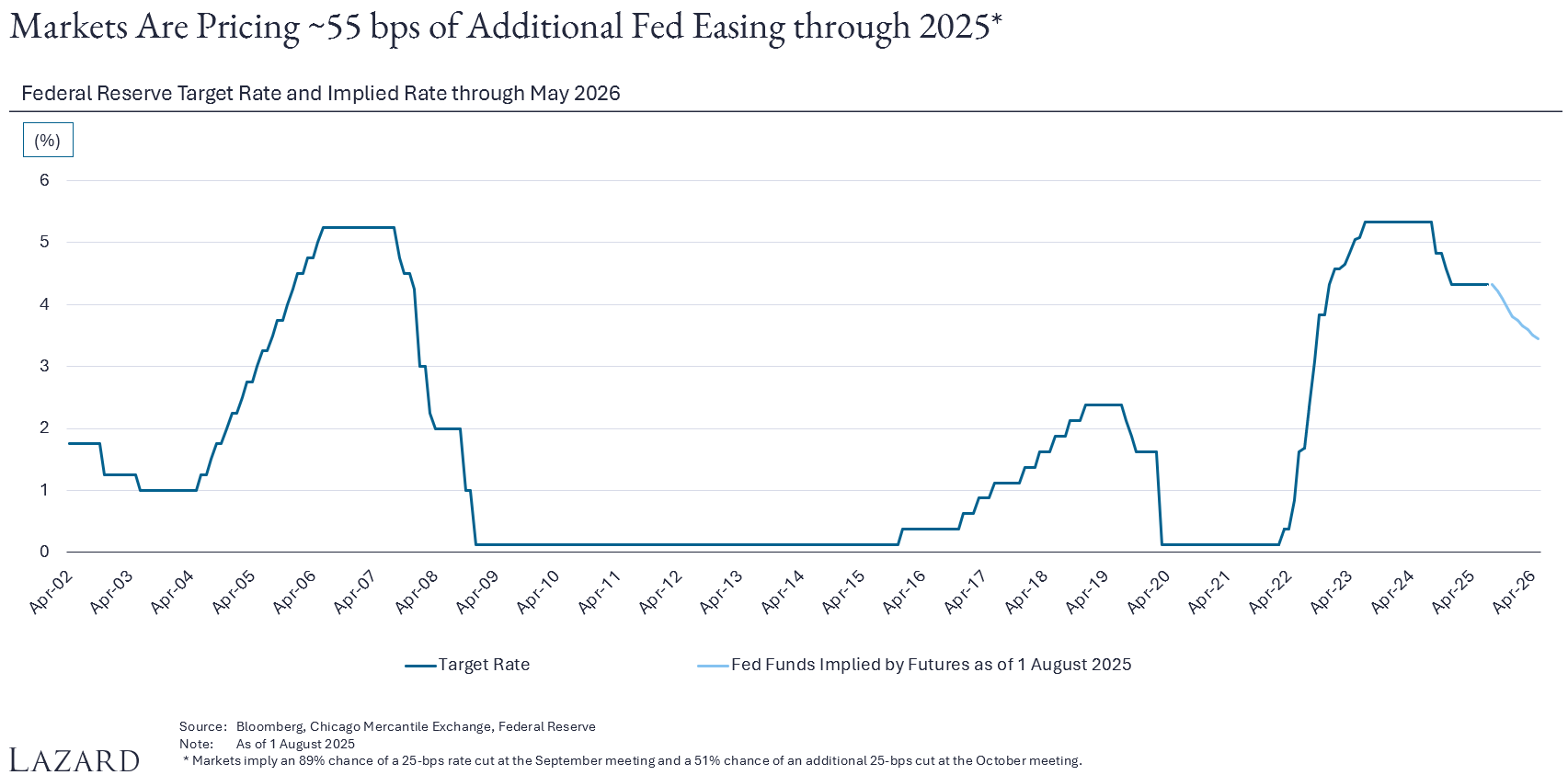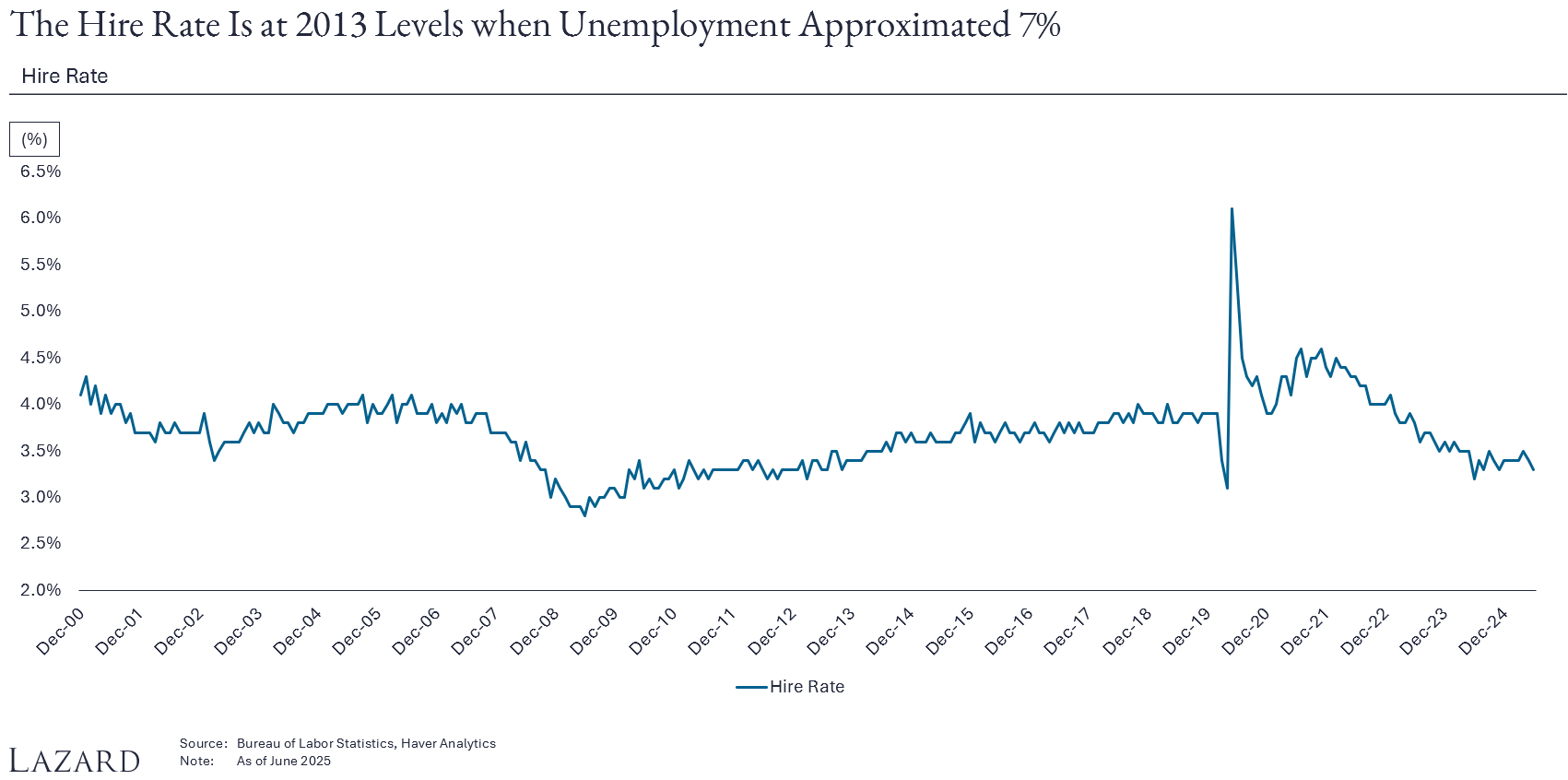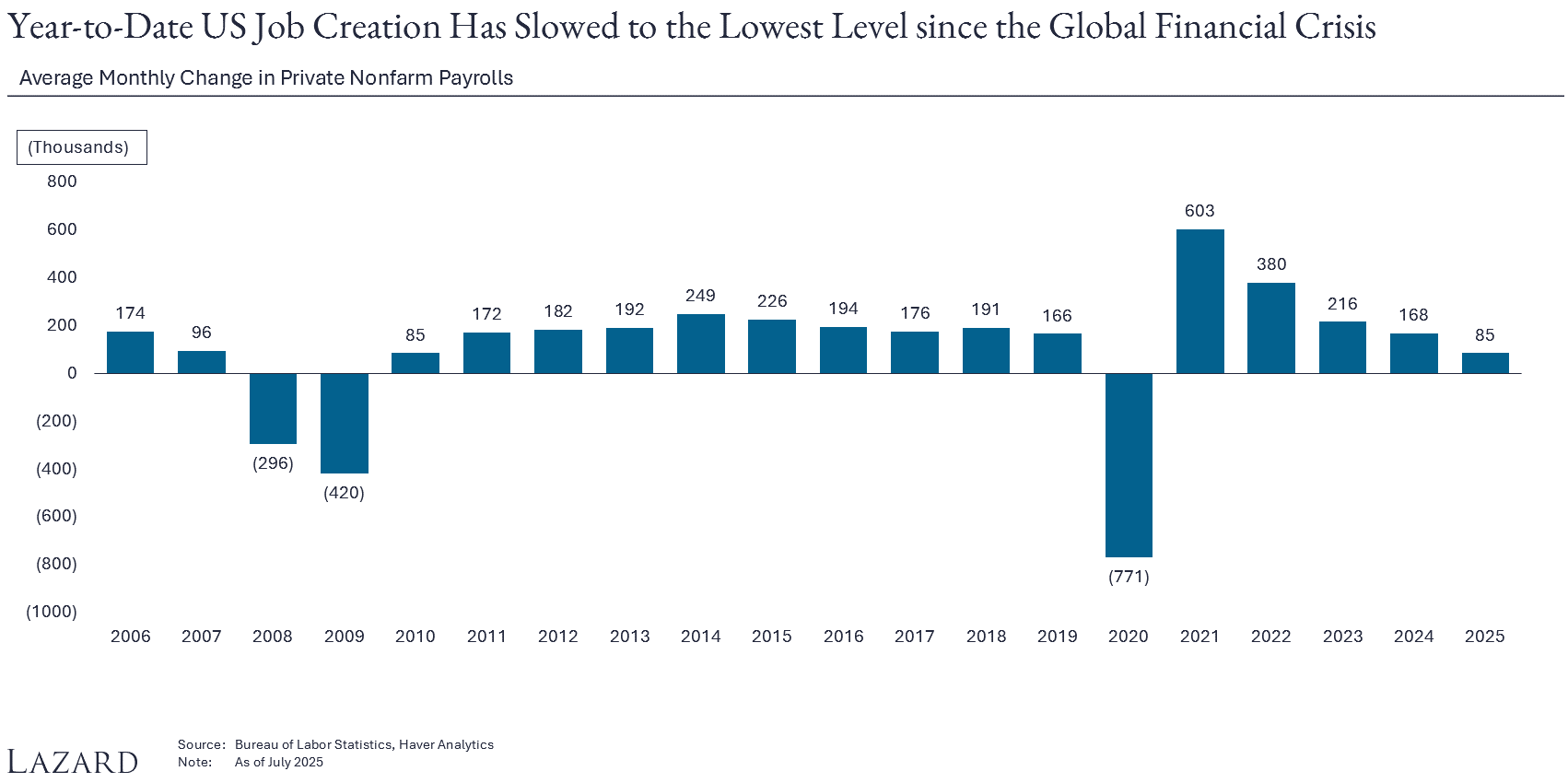US policy puts pressure on inflation and growth expectations
Ronald Temple, Chief Market Strategist at Lazard
1. The United States and European Union agreed to the outlines of a trade accord.
The outlook: While the terms of the agreement were less bad than the potential 30% tariff President Trump had threatened as of 1 August, the 15% tariff still represents a material increase in the cost of goods imported into the United States. The effects on both the EU and US economies are likely to be negative with lower growth in the European Union and higher inflation in the United States. In both economies, it appears likely that the tariff increase will lead to lower corporate profit margins.
The details: The broad outlines of the agreement were reached in a one-hour meeting in Scotland between President Donald Trump and European Commission President Ursula von der Leyen after months of negotiations between the United States and European Union. The key terms of the agreement include:
- 15% US tariff imposed across EU exports including autos and auto parts.
- Semiconductors and pharmaceuticals are initially covered by the 15% tariff as well, but upcoming Section 232 investigation results are likely to lead to higher tariffs on these goods.
- 50% tariff on EU steel and aluminum exports (2% – 4% of EU exports to the United States) remains in place, but Von der Leyen indicated the two sides agreed to subsequently reduce these tariffs and replace them with a quota system.
- Both sides will adopt “zero for zero” tariffs on aircraft, certain chemical and agricultural products, and various raw materials.
- The EU agreed to purchase $750 billion of energy products, semiconductors, and military equipment ($250 billion per year over three years) while also investing $600 billion in the United States through Trump’s second term. After the announcement of the agreement, the European Union acknowledged that it has no authority or mechanism to invest $600 billion in the United States, highlighting the questionable nature of commitments such as these in trade negotiations.
2. The United States announced tariffs on 69 other trade counterparts ranging from 10% to 41% effective 7 August.
The outlook: The US trade story is not yet over, but the key country-level tariffs are likely to remain largely in place into 2026. The next chapter of the story is likely to focus on sectoral tariffs for semiconductors, pharmaceuticals, lumber, and aircraft. There will be room for countries to continue negotiating trade agreements to reduce their tariff levels for exports to the United States, but attention will also likely shift to the renegotiation of the United States-Mexico-Canada Agreement (USMCA) late in 2025.
The details: The United States set a minimum 10% tariff on imports, as expected, and set a 15% tariff on countries with a trade surplus against the United States. The United States also imposed higher tariffs on some important trade counterparts. Notably, the tariff on imports from Taiwan was set at 20%, Switzerland at 39%, and India at 25%. Goods from Canada that are not USMCA-compliant will be subject to a 35% tariff. The United States announced another 90-day extension of negotiations with Mexico during which time the tariff on goods imports that are not USMCA-compliant will be set at 25% while steel and aluminum imports will be subject to a 50% tariff. Mexico agreed to remove all non-tariff barriers during this period.
Goods transshipped through a different country will be subject to a 40% tariff to try to prevent tariff evasion with a focus on Chinese products. The de minimis exemption will also end as of 29 August with significant implications for direct product shipments from China to US consumers.
3. The Fed held rates constant, as expected.
The outlook: As expected, the Fed held rates at 4.25% – 4.50% and made no changes to the pace of quantitative tightening. After the meeting, markets decreased the amount of policy easing expected by year-end to only 33 bps, the lowest amount since February. However, after the Friday employment report, markets reassessed this view and sharply increased expectations for rate cuts to 55 bps by year end. I continue to believe the Fed will not reduce rates at all this year given rising inflation caused by tariffs and a relatively stable unemployment rate.

The details: In a 7-2 decision, the Fed held rates constant. During the press conference after the release of the FOMC decision, Fed Chair Jay Powell indicated that “in coming months” the Fed will receive a good amount of data that will indicate the degree to which tariffs will translate to higher inflation. He also noted that the “economy is not performing as if restrictive policy were holding it back inappropriately.” Powell said the labor market is still in balance with quits, job openings, and the unemployment rate all stable. He acknowledged that payroll growth is decelerating but also correctly suggested that the unemployment rate is likely to be a better gauge of employment conditions given the sharp reduction in immigration into the United States which lowers the “break-even” rate of job growth required to maintain a stable unemployment rate. Powell reminded the audience that GDP growth is not the Fed’s mandate. Instead, the Fed’s mandates are to maintain stable prices and maximum employment.
Chris Waller and Michelle Bowman each released statements after the FOMC meeting explaining their dissenting views. In each case they highlighted concerns over labor market weakening and argued for cutting rates now to avoid unnecessary damage to employment. While I am somewhat sympathetic to their arguments, and have considered them thoroughly, I would align with the majority of the FOMC members who believe it is more appropriate to hold policy constant until there is greater clarity in terms of the effects of tariffs and stricter immigration enforcement on inflation and employment.
4. Headline US GDP rebounded more sharply than expected in Q2-25, but the first-half figures were obfuscated by large swings in imports.
The outlook: I expect US GDP to decelerate because of tariffs and stricter immigration enforcement. Tariffs are likely to reduce real income for American workers as price increases accelerate faster than wages. Stricter immigration enforcement is likely to reduce potential GDP growth, as the pace of economic growth for every economy is driven by two factors: the number of hours worked by its citizens and the productivity per hour of work.
Until recently, the United States enjoyed potential GDP growth of 1.7%–2.0% per annum driven by moderate immigration inflows, domestic population growth, and productivity gains. With the sharp decline in migrant arrivals combined with a significant increase in deportations, I expect the population component of US GDP growth to decline by as much as 50 bps per annum reducing potential GDP growth to 1.2%–1.5% per annum. This does not affect GDP per capita as the change is driven entirely by population growth, not productivity.
The details: Real GDP rose in Q2-25 by an annualized 3.0% rate versus an expected 2.5% increase. This growth followed a decline of 0.5% in Q1-25, with the bulk of the large swings being driven by net trade figures. In Q1-25, imports surged as companies tried to front-run tariff increases. In Q2-25, these import figures fell back to more normal levels.
Within the GDP report, I focus on final sales to private domestic purchasers. This metric removes trade-related volatility as well as any government spending effects. The growth rate of final sales to private domestic purchasers fell to 1.2% q-o-q annualized from 1.9% in Q1-25 and was the slowest increase since Q4-22.
Net trade added 5.0 percentage points to the annualized growth rate in Q2-25 after detracting 4.6 percentage points from the Q1-25 rate. Gross private domestic investment subtracted 3.1 percentage points from the growth rate in Q2-25 after adding 3.9 percentage points in Q1-25.
5. US labor market reports revealed further softening in job growth but slightly higher wage gains.
The outlook: Changes in immigration policies are likely to lead to a sustained downshift in US employment growth. The effect on unemployment, however, might be relatively limited as lower immigration means less growth in labor supply at the same time labor demand is also likely to weaken due to lower growth in consumption. In recent months, we might have gotten an early glimpse of how this will play out over time with the labor force, total employment, and the unemployment rate stabilizing.
I am increasingly of the view that nonfarm payroll growth is likely to weaken further but that the unemployment rate might not move materially higher. If that is the case, there is little reason for the Fed to cut rates in what appears to be a full-employment economy.
The details: This week was a busy one for labor market data. The Job Openings and Labor Turnover Survey (JOLTS) showed a decline in job openings from 7.71 million to 7.44 million. The job openings, quit, and hiring rates all nudged lower. The hire rate fell to 3.3%, a level more typical of 2013 when the unemployment rate spent much of the year above 7%.

The monthly Employment Situation report indicated that nonfarm payroll growth fell short of expectations. But more importantly, results for the prior two months were revised sharply lower by 258,000 jobs in total such that job growth on a year-to-date basis has now fallen to only 85,000 per month, the slowest pace since 2010.

Even while employment growth decelerated, labor costs rose slightly more than expected. The Employment Cost Index, the most comprehensive assessment of compensation pressures, rose by 3.6% year-on-year (y-o-y) in Q2-25 versus 3.5% in Q1-25. I do not expect wage growth to reaccelerate given the softening of the labor market, but the Fed is likely to focus on this data carefully to ensure that tariff-induced inflation does not translate into higher wage pressures.
6. US Personal Consumption Expenditure (PCE) inflation rose more than expected in June, and April and May figures were revised upward.
The outlook: I expect PCE inflation to reaccelerate, alongside Consumer Price Index (CPI) inflation, as tariffs work their way through the supply chain to consumers. The increase is likely to exceed 100 bps given the ~15 percentage point increase in the weighted average tariff on goods imports into the United States. With core PCE inflation currently running at 2.8% y-o-y, we are likely to see core PCE inflation top 3.5% by early 2026.
The details: Headline PCE inflation rose 0.3% month-on-month (m-o-m) and 2.6% y-o-y in June while core PCE rose 0.3% and 2.8%. May figures were revised higher to 0.2% m-o-m and 2.4% y-o-y for headline PCE inflation while core PCE was only revised higher for the y-o-y figure to 2.8% from 2.7%.
Personal income and spending both rose 0.3% m-o-m in June.
.jpg)